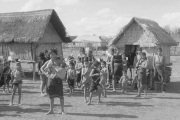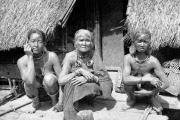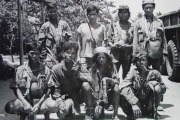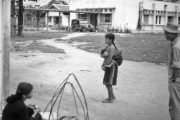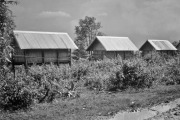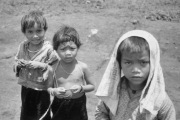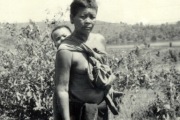
In the highlands of Vietnam and Cambodia, there live about 30 different tribes of aboriginal people. Their half-dozen or so different languages and dialects are of the Malayo-Polynesian, Tai, Austroasiatic and Austronesian language families, suggesting they are early migrants from the South Pacific. The tribes’ names include Gia Lai, Xo Dang, Ro Mam, Ba Na, Brau, Mnong, and others. The French, however, called them all ‘Montagnards,’ or ‘people of the mountain.’ Those who have migrated to the United States refer to themselves this way, but those who remain behind use their tribal names.
The Montagnards are farmers and hunters who live a primitive lifestyle. They grow mostly rice and manioc, moving to a new location when the soil no longer supports them. The different tribes have their own customs and dress. In some tribes, the men wear loin cloths, and both men and women have historically been bare-chested. In their travels around Pleiku and Kontum, it is likely that the men of the Snake Platoon were taken aback at their first encounters with these primitive people.
These are tough people who live a hard life. They are fiercely loyal to their friends, and they can be a nightmare for their enemies. Some neighboring tribes get along well, feeling a spirit of kinship. Other tribes detest and make war on each other. There have long been tensions between them and the Vietnamese over issues of land ownership, cultural preservation, access to education and political representation.
In the 19th century, French missionaries worked with various Montagnard tribes and converted many of them to Catholicism. In the 1930s, American missionaries converted many more to Protestantism. Today, about half of the Montagnard people are protestants and another 200,000 are Roman Catholic. The mountain tribes people have a higher proportion of Christians than do the ethnic Vietnamese, who are more likely to be Buddhist or Daoist. Despite their conversion to Christianity, like many tribal peoples, the Montagnards hold on to a remnant of their old religious beliefs, involving many spirits associated with nature and ancestors. Their villages maintain sorcerers and shamans to intercede on their behalf.
From its earliest days, the Vietnamese Communist Party was suspicious of these mountain tribes, particularly during the Vietnam Wars. It was recognized that they would be more likely to support the predominantly Christian French, and later American, forces due to their religious ties. With the hostility of North Vietnam and communism in general to religion, most Montagnards, with the exception of some tribes actually located in North Vietnam, sided with the South Vietnamese, despite the animosity towards them from the ethnic Vietnamese. Also contributing to this shaky alliance was the tribal people’s antipathy to the strong centralized government offered by the communists.
The US Special Forces were stationed primarily in the Central Highlands and trained Montagnard forces in guerilla tactics. They also provided them with more modern weapons than the ancient rifles and hand-made crossbows they had been using. Montagnards worked side-by-side with the Special Forces to disrupt communist supply lines and advances. They contributed mightily in attacking North Vietnamese activity along the Ho Chi Minh trail across the border in Cambodia.
In revenge for the hill tribes’ allegiance to the government of South Vietnam, the Viet Cong entered the Montagnard village of Dak Son in 1967 and killed 252 of its 2,000 residents. This slaughter became known as the Dak Son massacre. The Montagnards continued to support the anti-communist South until the end of the war in 1975.
After the fall of Saigon in 1975, the mountain tribes feared reprisal from the new government for their support of the US forces and the South Vietnamese. As a result, thousands fled to Cambodia, and the US military resettled some of them (fewer than 2,000) in the United States, primarily in North Carolina. The Vietnamese government continues to displace tribal villages in the Central Highlands in order to establish coffee plantations. On May 30, 2020, the Viet Nam News contained an article that the government is embarking on a program to improve the lot of ethnic minorities and those living in the Central Highlands. Both of these terms point to Montagnards. The plan is that, during the period 2021-2030, Montagnards’ incomes will be doubled to be equal to one-half of the national average.
If the photos on the internet are any indication, many of the Montagnard tribes, much like some Native American tribes, have become tourist attractions. The net contains many photos of Montagnards posing in their tribal dress and performing their ancient ceremonies and dances for the tourists’ benefit. More candid photos reveal them wearing clothing more typical of a modern tropical small town, with the occasional motorcycle in view. Their culture appears to remain only for the sake of tourism.
Return to Explore Some More.

